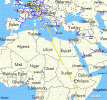
Flight Munich Amsterdam Nairobi
Private homepage – Hans-Georg Michna
Kenya travel reports: 1999, 2000, 2002, 2003, 2004, 2005, 2006, 2007, 2008, 2009, 2010, 2011, 2012, 2013-Goma, 2013, 2014, 2015, 2016, 2017, 2018, 2019
Kenya Safari Travel Plan, Kenya 1980-2000 photos
Kenya 2007
A personal travel report from Kenya in May and June 2007
If you prefer only a small photo selection, click here.
Last change 2007-08-09 Copyright 2007-2023 Hans-Georg Michna
Click on the small pictures to see them enlarged, usually to 800 x 600 pixels.
Times are given in local Kenyan time in 24h format (without "am" or "pm"), i.e. 0:00 to 23:59 o'clock.
A few readers had the problem that after clicking on a picture, then going back to the main page, all thumbnail pictures were reloaded. This is typically caused by Internet Explorer cache corruption. It can often be repaired by going to the Internet options and deleting the temporary Internet files.
All photos are subject to copyright . If you want to reuse any photo, send me an email asking for permission, and I can send you the full-size photo, usually 1,600 x 1,200 pixels. Photos bear the copyright 2007-2023 Hans-Georg Michna.
[Still the same cameramy Panasonic Lumix DMC-FZ1-2 digital camera. Most photographs in this travel report are reduced to 800 x 600 pixels and JPEG-compressed with medium strength to make them more palatable for the web.]
| Departure | Arrival | Flight | Status |
|---|---|---|---|
| 06:55 So 27 Mai 2007 Munich |
08:30 So 27 Mai 2007 Amsterdam (Schiphol) |
KL 1790 | Seat reserved |
| 10:15 So 27 Mai 2007 Amsterdam (Schiphol) |
19:10 So 27 Mai 2007 Nairobi |
KL 0565 | Seat reserved |
| 11:10 So 24 Jun 2007 Nairobi |
19:10 So 24 Jun 2007 Amsterdam (Schiphol) |
KL 4140 | Seat reserved |
| 21:05 So 24 Jun 2007 Amsterdam (Schiphol) |
22:30 So 24 Jun 2007 Munich |
KL 1801 | Seat reserved |
My travelling checklist in michna.com/kenya.htm#Preparations (German version michna.com/kenia.htm#Reisevorbereitungen) saves me again from pre-travel stress.
2007-04-25 The manager of the Aero Club of East Africa wrote: "A single has been booked for the nights of the 27th - 29th May inclusive and for the 27th June, at a rate of 2300/- inclusive of breakfast [...]." Currently 1 is about KSh93, so these prices are very moderate.
2007-05-26 Now I'm really packing. Everything looks good. Expect no delay.
I was particularly glad about KLM's web check-in that I just did. I have already reserved seats and printed my own boarding passes, which will hopefully shorten my time on the airport tomorrow morning. Now I don't have to check in thereI only have to go to the luggage drop-off point.
Addendum: As it turned out, I was the only passenger in Munich who had done the web check-in, which was appreciated by the ground crew, but didn't speed me up greatly. But it worked. My self-printed boarding pass carried me all the way. I can see though that it would speed up the physical check-in at the airport if most people checked in via the web, and I was very surprised that nobody else did, given that it's pretty easy to do.
There was bad weather in Amsterdam, very low clouds, which delayed my arrival. The airport used only one runway and kept us flying holding patterns (the right turn racetrack of the Instrument Flight RulesIFR, instead of the left turn racetrack of the Visual Flight RulesVFR).
The flight on to Nairobi was also delayed by almost an hour, but the plane, the biggest passenger plane currently in service, a double-decker (not wings, passenger levels) Boeing 747 "Jumbo", flew very fast and arrived almost at the original schedule time.

Flight Munich Amsterdam Nairobi
A landing in Nairobi is always spectacular, because with the usually prevailing easterly Passate (trade) winds one flies right by the city in the final approach and crosses the Mombasa Road shortly before touching down.
Nairobi International Airport, because of its height, its heat during the day, therefore rather thin air, and therefore higher landing speed (probably higher than 300 km/h), has a 4 km runway, and the heavy bird used up an estimated 3 km of them, in spite of using both reverse trust and wheel brakes, until it was slow enough to turn off into the new taxiway to the terminal building.
The visa procedure was quick, because I meanwhile know a non-obvious other visa counter (turn left when you're at the obvious one, then walk along the corridor until you see the other one), my luggage also arrived in good shape, the jeep was also there (thanks to Shahid Rasul's good preparation), and so I made it into my Nairobi base, the Aero Club of East Africa, without any problems. Nicely, the Aero Club has a WLAN now, so timely updates of this travel report are assured, at least whenever I pass through Nairobi.
The first of June, the coming Thursday, is Madaraka Day, a public holiday in Kenya. I hope to have everything organized by then, particularly the extension of my pilot license, and leave on Madaraka Day at the latest. So far I have not planned where I will go from there, and I don't actually have to plan that much earlier. Let's see.
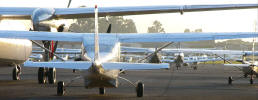
Wilson Airport in the morning sun
[Wide angle panoramic photo thanks to the computer program Autostitch]
At first everything went nicely. I went to the doctor, a senior Englishman, who sent me to Nairobi Hospital across the street for an ECG and eventually wrote me a medical certification. With that and all other required paperwork I drove to the KCAA (Kenya Civil Aviation Authority) and handed everything in, as usual. The KCAA is at the international airport, i.e. quite a bit away from the city.
Here came the first surprise. They said they are issuing new licenses and need four passport photos. No problem, I had expected this for a hundred years and, of course, had even more passport photos with me. But they said these are too big. I proposed to cut them around my face, but they showed me that they would still be 1 mm too high. So I proposed to glue them in 1 mm higher, on, instead of under, the black line. No, they said, that's not permissible. The photo must be under the black line. But they offered me that they would prepare everything, I could hand the photos in tomorrow, and I could then wait for the license.
Fair enough. I went home (the Aero Club of East Africa is my Kenyan home) and looked for a photo studio the next morning.
My first try was successful. I drove over to Yaya Centre, A nice shopping mall not too far away, and found a camera shop there. The passport photo machine was broken, but they could do it right in the shop. Judge for yourself:
![]()
My portrait
As you can see, they nicely gave me the file as well. They copied it (a bit bigger than the sample above) to a memory stick that I always carry around.
Anyway, I passed by Rasul's to collect a tow rope and roll the credit card, then went to the Aero Club of East Africa for a little lunch, and drove to the KCAA in the afternoon, as agreed, to bring them the smaller photos and collect my license.
However, they discovered a mistake. The doctor hat written the date of the examination as May 2008, rather than May 2007. Being correct bureaucrats, they had to refuse this. But they offered that I could come after the opening hours, until 17 o'clock, to collect the license.
So I rushed back to the doctor and had to use all tricks to avoid the totally congested main road to make it in time, have a new certificate issued, and drive back to the KCAA. Then they began to actually type the license.
On the way back I took a hitchhiker, a boy who went home from his boarding school. We chatted the whole time, but then we got into a pretty bad traffic jam, even before we reached the first roundabout of Nairobi, a foretaste of today's city traffic that I had so far avoided.
I had already heard that the road traffic in Nairobi has reached its sensible limits this year. They record about 5,000 new car registration every month. Kenya's upper middle class is growing fast, but Nairobi's city structure is very unfavorable, due to several small rivers cutting through large parts of the city and due to relatively dense building, so it is difficult to build more roads, not to mention that the Kenyan government's greatest strength is not providing good infrastructure (or providing any well-functioning service, for that matter).
Anyway, this ate up all my daylight time, and when I reached the Aero Club, the sun was about to set. When I tried to extend my stay in the club by one more night, I learned that the guest rooms are fully booked, perhaps because of the impending holiday and because of a big meeting that evening. Things weren't going the way I wanted.
The Aero Club was fully booked, and nobody so far cancelled his booking, so I had to move. The good side is that this gave me the chance to try out a recent recommendation, Shalom House. I called them, then moved over in the afternoon. It is not very far from the Aero Club, so will be a good alternative whenever the club is fully booked. And it was directly on the way to a meeting point with the Amboseli Trust for Elephant directors in one of the best Italian restaurants of Nairobi. Until then I sat on the Aero Club terrace, typing this.
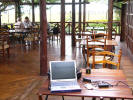
The open-air restaurant of the Aero Club of East Africa
The people visible in the photo spoke German. Behind me is the bar, to the left the garden and the swimming pool. The world has its nice places.
Everything happened as planned. Shalom House seems eminently useful and relatively inexpensive. It also has some flair. There is a restaurant and an Internet caf in the compound, for example. The accommodation is minimalistic, but functional. It includes a mosquito net and a shower.
The Italian restaurant, the Mediterraneo in The Junction, a shopping mall at Dagoretti Corner, was quite good and in walking distance from Shalom House. To top it all off, we went to the movie theater, also in The Junction, and saw Pirates of the Caribbean 3: At World's End, in my opinion the best of the three so fara B in my A to D movie grades.
I went back to the Aero Club of East Africa for a meeting of private and commercial pilots over the topic of security, mainly about the question what we private pilots can do to make the life of the professionals easier. I found it very interesting. On the sidelines one commercial pilot there told the story how he survived a bad bird strike to a Cessna Caravan that knocked him unconscious, as the windshield was pushed in and hit his skull with near-deadly force. As a result of this, the small airlines have now changed procedures to defend against this risk. No high-speed descents any more, as this accident happened when the plane dropped out of the clouds, descending to an airfield at high speed, and the birds were just under the clouds.
Then I sat on the terrace again at night, watching somebody doing night training circuits in a single-engine Cessna, eating onion soup, and typing this travel report. Finally I drove back over to Shalom House for a short night's sleep with the plan to leave Nairobi before sunrise in the direction of Naivasha and Nakuru.
And so I did. At sunrise I was already rolling and elegantly bypassing all but 500 m of the early morning traffic jam by leaving Nairobi tangentially, without touching the inner city.
Soon I reached the edge of the Great Rift Valley and could see the Mt. Longonot volcano and Lake Naivasha.
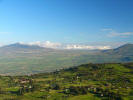
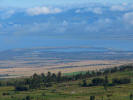
Rift Valley, Mt. Longonot, Lake Naivasha; Crescent Island, a submerged volcano
The road was recently redone past Naivasha and on to Gilgil. There I hit the road builders. The road was blocked and traffic diverted over an old, unpaved road. On the shoulder of a hill the water had washed out a deep hole, blocking half the road. For the limousines it was difficult to get around it, because they first had to convince the oncoming traffic to stop at enough distance from the hole, so they could drive around it. So some drove through it, and I'm sure a lot of cars were damaged there, like the exhaust broken or bent. No problem for my jeep, fortunately.
The diversion continued throughout the Lake Elmentaita area, and the rest of the road to Nakuru was not much better. Still I got to Nakuru already around 11 o'clock, which is fairly quick.
I visited some people in the area, then drove to the little-known Lanet gate on the east side of Lake Nakuru National Park and into the nature reserve. I reached Lake Nakuru Lodge in time for lunch, then used the rest of the day for a long game drive through the southern part of the nature reserve, so I saw the many flamingos in the lake only from a distance.
I did see a lot of other wildlife. A large herd of buffalo, a medium sized herd of the rare Eland, and a whole bunch of an even rarer species, the Rothschild giraffe, with several young among them. I saw two large baboon clans, one group of Vervet monkey, lots of Impala, and two rhinos.
Towards the evening some clouds obscured the sun, reducing my photo light, and when I drove back to the lodge around sunset, there was a rainshower.
Along the track there was a bus with some people trying to repair something on the rear axle. The bus was full of schoolgirls on safari. I asked whether I could do anything to help, but they told me that they're about to have it fixed.
I drove on and had to stop, because two rhinos (not the same ones) stood on my path, a dam through a swamp. I stopped and waited, when the bus came and passed me. Some 30 m in front of the rhinos the bus driver stopped. Then he moved forward a few meters and repeated this a few times, until he was perhaps 10 m from the rhinos. Only then they gave in and very slowly moved down from the dam, freeing the way for the bus.
I followed closely behind, but then stopped to enjoy this very close look at two wild rhinos. But they didn't move away. Instead they turned to me and began to edge closer. I didn't want to continue that experiment and drove away. It was also getting dark, and I had to get back to the lodge.
The dinner was even better than the lunch. This is not a place to lose weight.
I can't remember ever having been here in such rainy weather, but it rained in the night, and it kept raining lightly, on and off, throughout the morning.
I woke up at sunrise and did an early-morning game drive, came back for breakfast around 8:30 o'clock (wonderful pancakes), then grabbed my bag and left. I had time until 13:00 o'clock, so I drove through the southern part of the nature reserve again in a wide arc, then north along the lake shore to the main gate towards Nakuru town. Some photos from this morning:
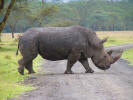


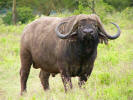
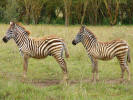
A morning in Lake Nakuru National Park
In Nakuru I checked into a new hotel named Merica, which was OK, apart from some minor glitches, like no shampoo in the room (actually typical for Kenyan hotels, but not for wildlife lodges), light switches wired wrongly, etc. Its architecture reminded me of some expensive hotels in Germany, but those are 5 to 8 times as expensive.
After checking in and leaving my luggage there, I went straight to the Dream Cyber World to meet a friend, Red, who runs the outfit, and to upload this page. In the evening we went to an Ethiopian restaurant with Susan, a young woman whom I had known only be email and who happens to live in Nakuru. There was so much to chat, we could have filled many more evenings without getting bored.
Early in the morning I passed by the two Barclays ATMs to get more money, but both were out of order. I'll have to fall back to the credit card.
Apart from some potholes near Nakuru and and excessive number of speed bumps the road was very good, up to Marigat.
The last bit to Baringo, however, had had rain floods, and the road had been swept away in two places, not mentioning many sand and detritus barriers the water flows had deposited on the road.
The water was still flowing, so I had to cross two rivers.
I reached Baringo at around 10 o'clock, after only 3 hours of driving, and moved into the house of friends, who run an agricultural project.
My time there was very interesting. I got to see some project sites, repaired and updated some computers, and had a nice time at the shore of Lake Baringo.
I woke up in a wonderful sunny morning, quite normal for Baringo, but beautiful for someone coming from the rainy Germany.
Because of the following two newspaper articles I thought very thoroughly about going a different (much longer) way or going elsewhere altogether.


Shootings, killings, cattle raids
Then I gathered some more information and decided to go to Maralal on the first day and gather more information on the go.
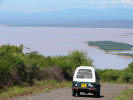
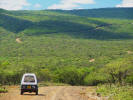
View over Lake Baringo; highlands east of the Rift Valley
This route leads through fantastic landscapes. The photo showing my jeep on a paved road is quite misleading. There are no paved roads beyond Loruk near the northwestern corner of the lake and the far Samburu. The short bit of asphalt shown in the photo is the only exception, and it is only a few meters long. After the next curve the pavement deteriorates to a state where one wishes it would never have been put there.
When I passed Mugie Ranch, I drove in and asked the residents about any problems, but they didn't think I would have any along the road. Then I asked a matatu driver, who had just come from Wamba, and he also said, no problem.
So I decided to skip Maralal and drive on. Normally I would leave earlier for the entire distance, but I had made good headway and wanted to camp out anyway.
I stopped another oncoming matatu and asked again, and again the driver said, no problem. So I continued the long way to Samburu.
In Lodungokwe I stopped to give some photos to Anastasia (see http://michna.com/kenya2004/), only to learn that she had moved to Maralal. By now I was too far past Maralal, and it fit the fact that I hadn't been able to take a suitcase full of clothes for her, because my luggage had been too heavy. She'll have to wait until next year.
Not long after 16 o'clock I arrived at Ngotogongoron airfield (my name, I don't know the official one) near the west gate to the Samburu nature reserve and decided to make my camp at the far end of the runway, because that was an easy way to move as far as possible from the track. I drove along the runway and then deep enough into the bush, so I wouldn't be visible.
Too late I noticed the noise from a relatively near Samburu settlement and decided to stay there in the hope that nobody would detect my presence. This was a false hope, as not much later a Samburu warrior arrived on the scene and came to my car. He was very friendly, but I still had to move on the principle that I only camp where nobody sees me. There's always a risk that he tells many people, and I could end up with obnoxious or even dangerous company.
So I quickly packed up and drove back along the runway to the other end and then some more. There I drove sideways into the bush, far enough that nobody should see me from the track, and camped anew.
This worked better, and I had a tin of beans and a bottle of water for dinner, followed by a long and quiet night.
I woke up a few times during the night to bright moonlight, but then I woke up when dawn had already broken. I got up and packed my jeep, when a whole bunch of Samburus came over, who had walked by on the track to get water. Unfortunately I couldn't find out whether they had seen or heard me, but I thought some more about the optimal camp site and will reconsider dry river beds, because they make it possible to drive deep into the bush easily. When a flash flood is likely, which it wasn't in my current situation, one could still drive out of the river bed and into the bush to make camp.
The guys were just as friendly as the first one last night, so I finished my packing while chatting with them and drove off to the Samburu west gate.
I've thought about camping right next to a Samburu settlement after asking them for permission, but there are a few problems with that. It isn't really quiet, everybody would gather around me, watch me and try to chat with me all the time, and there may even be a slight risk of hostility or robbery. There could be fleas too. So I keep sticking to my rule that I try to camp only where nobody knows.
I drove to the gate, only to find that they had raised their prices more or less in line with the most expensive KWS (Kenya Wildlife Service) nature reserves. Residents now pay KSh1,000 per night, a small car costs KSh800 per night (not per entry as earlier!), and non-residents pay $40 per night, which comes much closer to the cost of accommodation in the lower-price lodges, i.e. about doubles the overall price.
I continued to Samburu Lodge and got one of the best rooms they have. The lodge was not very busy. The high season had not yet begun.
The lodge has undergone some restructuring, hardly any of which increased its quality for me. There are additional sources of noise, the new parking place lacks shade, and there is a senseless barrier between the parking and the petrol station. Most tourist minibuses now park outside the new parking place under the trees near the employee quarters. I can't really admire the architect of these changes. But I still recommend this lodge. The deterioration does not destroy its other advantages.
The office secretary offers an Internet connection, a standard modem over a radio link land line on her office computer, but this type of connection is far too slow and unreliable, with frequent interruptions, to even do my email, not to mention uploading a web page with pictures. I would also have to connect my computer, which is not possible.
So I concentrated on game drives and photography, for the time being.
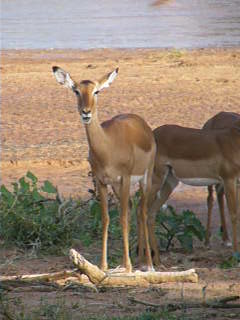
Impala ruminatingwatch its chewing and its neck in the
Video (WMV, 429 KB. Some players play this in
a distorted format. If this happens to you, try another player, like Media Player
Classic.)

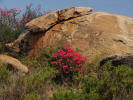
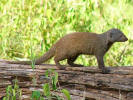


Elephant bull; Desert rose; dwarf mongoose; African buffalo; dik dik
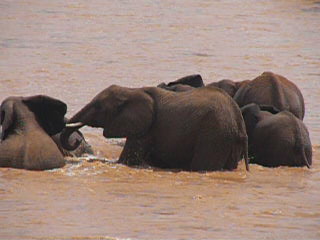
Elephants bathing in Samburu River
Video (WMV, 4.22 MB, some wind noise)
Today I had the opportunity to visit the Save The Elephants research station. As usual, the science and also the special bush technology are very interesting. For example, I saw elephant collars using GPS and data relay via mobile phone or satellite connections that can be remote-controlled by a special encoded radio transmitter to open themselves and fall off, sparing the elephant a second dart. I also saw the results of the data obtained with the help of these collars, and the data reveals new information about the migration routes of these elephants.
I also saw a truck that had been demolished by a raging bull elephant.
I met the driver of that truck. He had survived with minor injuries, but only because another elephant had helped him.
While I worked on the photos, a Vervet monkey mother with child peeped through my lodge room window.

Vervet monkey mother with child, peeping into my lodge room window
Some more photos, taken later in the day:
This morning I drove out with a lion researcher. I had actually believed that the lions had moved out, but for her it was stunningly easy to find them. I've learned a few lessons on lion tracking.
Before sunrise we had already found a male and a female. Then we found a lion mother with her two daughters on the other side of the river.
Some more photos, taken in the late morning:
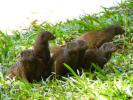
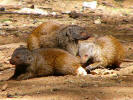
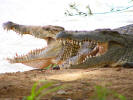


Dwarf mongoose (2 pictures); crocodiles; Oryx antelope; young Vervet monkey
On my way back from Samburu I stopped in Isiolo to check for Sarah, whom I had met in 2004 and later lost contact. Now, 3 years later, I could re-establish contact and finally meet her again.
We made sure that the contact by email will be more stable from now on, not only with me, but also with some other friends.
Sarah is looking for a job in Kenya or the surrounding countries, including, for example, the United Arab Emirates (Dubai). If you know a job for her, please send her an email.
Finally I left Isiolo and drove to Nairobi, which takes much of a day.
I spent a day in Nairobi, had my laundry washed, found an ATM that worked (rare these days), took the jeep to Rasuls for a quick check and cleaning, helped some people with their computers, answered 70 emails, and ate too well.
I got up early and drove out 15 minutes before sunrise, at 6:15 o'clock. Thus I could leave Nairobi in light traffic and drive down the Mombasa Road fairly fast.
Much of it is better than a German highway. The Mombasa Road has only two lanes, but side strips on both sides, where pedestrians, bicycles, and ox and donkey carts can move without inhibiting car traffic. At some distance from Nairobi the road surface also becomes perfect, so I could actually go at 100 km/h, which I do in Kenya only when the road and the car are perfect.
I reached Voi at 11:15 o'clock, filled the tank, and turned right into the road to Taveta, which is, unfortunately, incomparably worse than the Mombasa Road and paved only for the first few kilometers.
But it is not very far to the Taita Hills, the lodge with the same name, and the Salt Lick Lodge, which was my actual destination.
I had seen photographs of the Salt Lick Lodge, but had never been there. I think the lodge is an architectural masterpiece. It incorporates a number of good ideas, also in the interior design.
It is located in the Taita Hills Wildlife Sanctuary, a fascinating piece of hilly land with a system of swamps that shows all habitats from riverine forest to grass savannah. In size and organization it resembles Nairobi National Park and reminds me of a gigantic safari park with its fixed tracks and numbered junction markers.
After settling in and having a good lunch, I drove out to look at the sanctuary. Most of the time I spent with an uncommonly large group of elephant bulls.

Salt Lick Lodge Maktau Gate (Tsavo West) Kitani Severin Safari Camp
In the morning I had a nice breakfast, then left the lodge and drove to Tsavo West, Maktau gate.
At the gate I conversed with the ranger while watching a Cessna Caravan take off from Maktau airfield, a typical bush strip.
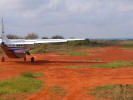
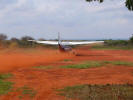
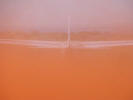
Cessna Caravan takes off from a bush airfield
The Cessna Caravan is one of the big success stories here. It looks as if it were designed specifically for Kenya's tourist shuttle business. Pilots like it too and call it lovingly, "The Van".
On my way inside Tsavo I had to cover some distance to reach the core area where the lodges are. South of and not far from Mzima Springs I encountered a horrific tsetse fly attack on my car. Suddenly I had a dozen of these bloodthirsty flies in the car and had to crank up the windows quickly, then tried to get at least some of them out, one by one.
I still got stung by several. When I stopped to watch the creatures, their attack sounded like a rain shower, as many of them collided with the windows and other parts of the car.
I had to put the fan on maximum to defy a heat stroke, but in the searing mid-day sun the car got so hot inside after a while that I had to move on. Opening the windows was out of the question, so I had to race out of the area of terror, sweating profusely in my car that had become a sauna. Only after several kilometers the flies became fewer and fewer, until I could finally open the windows again.
I learned a few things. One is that a tsetse fly getting into my car sooner or later hits a window and has a panic attack. After that the fly becomes harmless. As it desperately tries to get out of the car, it forgets its thirst for blood. This means that a tsetse fly coming into the car is mainly a danger within the first minutes, when it flies here and there at ankle level, seeking your blood. Another is that the panicking fly will sometimes land at the top edge of your window, and then you can crank down the window briefly to let it out while hoping that at least not several others will get in at the same time. I managed to get about half a dozen out that way.
I saw and photographed some other animals along the way.


Ostrich; Pale chanting goshawk
On my way through bushy areas I saw a lot of the beautiful Kudu antelopes, but could never photograph them, because they were extremely shy.
I decided to try a lodge that I had never been to before and drove to Kitani Lodge, not very far from the well-known Kilaguni Lodge. When I drove into the lodge compound, it was like a ghost town. The office was open, office tools were on the table, but there was nobody there.
I walked around the compound and into the employee quarters and finally found two men working on some car part in a workshop. They brought somebody in charge, and I was told that the lodge has no guests, but is working. They also have self-help bandas (huts). And there is the sister lodge, the nearby Kitani Severin Safari Camp. I drove there to check it out and found a very beautiful tented lodge, certainly not the cheapest, but still within my price range, and just right after the long tour.
After dinner they lit a camp fire, and one could watch the hippos that came from a nearby pond grazing at amazingly close distance.
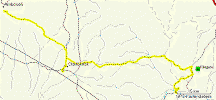
Tsavo West Oloitokitok Amboseli
The next morning I left at sunrise after a quick cup of tea and drove out of Tsavo, first to the north.
The exit is Chyulu Gate. While waiting for the bureaucracy, I looked up and saw lots of bats, who had chosen the thatched roof as their daytime sleeping place.
Driving on towards Finch Hatton's camp, I met a cheetah on the track, but he was very shy and kept running away until he finally turned off into the high grass.
I turned off towards Oloitokitok into an undescribably dusty road. My whole impression of Oloitokitok, a border town, is very bad. The place has no street infrastructure, everything is extremely dusty.
I went there only for shopping, bought vegetables and drinks, and turned away as quickly as possible, to continue to Amboseli, which I reached in the afternoon.
Amboseli was as peaceful and beautiful as ever.
The first day I didn't do much in terms of wildlife watching or photography. Instead I settled into the research camp and met the researchers.
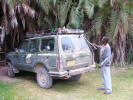
Cleaning the car of dust in the morning
The next morning I went out with a car especially equipped with a very low frequency speaker and observed how they did a playback session. The idea is to play various sounds, of lions, a known elephant, or an unknown elephant, to a group of elephants and observe their reaction.
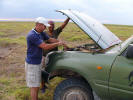
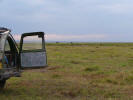
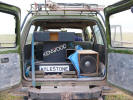
Graeme and Katito attach the power cables; the elephants are coming; the infrasound
and sound speakers
The procedure:
The results are very interesting, but since this is yet unpublished material, I won't go into the details at this time. What had already been known is that older, experienced elephants recognize far more than 100 other elephants by their voices.
In the afternoon we went out again for some more playbacks and watched a wonderful sunset.
And here is the sunrise after a not so quiet night. The local lion pride roared several times some 300 m from the camp, and throughout the night the two local buffalo bulls grazed in the camp. They always do that after the camp lights go out, but this time they spent much time at my tent, so I was listening to them for a long time, rather than sleeping.
You have to make some funny decisions here. For example, after the lions roar, you have to estimate how long it can take them to reach the camp and decide whether that time is enough to go to the toilet. Of course they might go elsewhere, but they do walk through the camp often enough, and since they can see much better at night than we diurnal humans can, I prefer not to face them at night if I can help it.
They don't attack tents though. In fact, they don't attack humans either, but there can be accidents, for example, when there's a bush between you and them, so they might think you're prey, and you bump right into them within their critical distance when you pass the bush. Let me put it this way: There is some small residual risk when you walk towards lions at night.
Monday morning (2007-06-18), after a starry, moonless night, we measured 8C. These nights were unusually cool in Amboseli, but in the afternoon temperatures still rise above 25C, particularly in the car, under the relentlessly beaming sun.
During the whole morning the mountain stayed clear of clouds, and I met Graham on another playback tour.
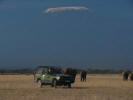
The infrasound-speaker-equipped jeep in action
Some more photos:
My plan suddenly changed, and I went back to Nairobi to meet a director of the Amboseli Trust for Elephants. The drive was uneventful, but the road from Amboseli to Namanga has meanwhile deteriorated to a state where most people, including myself, drive next to the road, rather than on it. The road has developed a kind of coarse corrugation that my little jeep cannot deal with, except at 20 km/h.
Still the most difficult part was not to get to Nairobi, it was to get into Nairobi, which took one hour, and to get through Nairobi, which took almost another hour. Yes, the traffic is that bad.

Nairobi Mai Mahiu Narok Masai Mara (Fig Tree)
The next morning I started early and took the following photograph from Limuru Road.
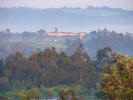
Kenyan highland in morning fog, looking west towards the edge of the Rift valley
On the way I took a hitchhiker from somewhere around Ntulele to Narok, a young woman, stylishly dressed in a short-armed pullover with thin stripes in colors on a dark background that reminded me of both the traditional Maasai adornment colors and the warm colors of African nature.
Her name is Evarlyn Naserian Kararei, and she's Maasai. You won't be able to pronounce this name perfectly. Maa (the language) has some truly difficult pronunciation rules, which I also don't fully understand. For example, the same word can be pronounced differently, if want it to refer to a man, woman, or child. I like to listen in on Maa conversations, because they sound truly exotic to me.
But she seemed like no relation to the tourist Maasai lingering along the road near Masai Mara. She runs a family farm in the area. She has a mobile phone like every modern Kenyan. She spoke fairly good English and was friendly, self-assured, curious, and perfectly beautiful.
In fact, I mused for a while over differences in body shape and came to the conclusion
that most of us pale caucasians are a lot more soft and soggy than, say, a Maasai,
perhaps partly because we sit too much, we eat too much unhealthy food, and we exercise
and move around too little, so gravity takes much more of a toll on us.
![]() Compared
to Evarlyn Naserian, many wazungu (plural of mzunguwhite person, European) look
decidedly degenerate to me.
Compared
to Evarlyn Naserian, many wazungu (plural of mzunguwhite person, European) look
decidedly degenerate to me.
Here's something she said, that may give you an idea at least for a second name of your next daughter, "If you get a daughter, call her Naserian. That's a beautiful name."
So she seemed to like her second name best. I also regret that I didn't take a photo.
In spite of truly terrible roads, I made it to Masai Mara in time for a late lunch at Fig Tree Tented Camp. Inside the Masai Mara nature reserve, shortly before reaching Fig Tree Tented Camp, I saw a not very happy looking truck driver.
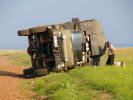
Unhappy driver after going into a curve too fast
I settled into the lodge and later went out again for an evening game drive. I had already seen the incredible density of wildlife in this area on my way, including elephant, buffalo, zebra, Topi, Impala, Grant's gazelle, Thompson gazelle, ostrich, and many smaller birds. To top it all, I saw lions eating a buffalo.
It was a large pride with one male. They had already eaten most of the buffalo, and the younger members were now trying to get the last bits of it.
While I was watching, four jackals appeared, and the boldest or hungriest one tried to pinch a bit from the buffalo, but the lions wouldn't tolerate that and chased the jackal away.

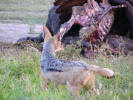
Black-backed jackal trying to steal a piece from the buffalo
The next morning I drove straight to the remains of the killed buffalo. The lions were still there, but some of them moved away slowly. I left the kill and returned to it after breakfast. Then the last lion left, the four jackals moved in and kept the vultures at bay that had gathered nearby.
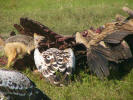
The jackal could not keep the vultures at bay forever
Eventually the vultures moved in and the jackals gave up against their large numbers.
Vultures are good at tearing out pieces that neither lions nor jackals can get at, for example, the tissue that holds the ribs together, forming the rib cage. After the onslaught of the vultures all ribs were separated.
Even a marabu stork tried to sneak in, but the vultures didn't let him eat. He soon gave up.
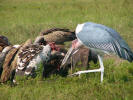
Marabu stork tries in vain to get his share
Then the hyaenas came. They are a different kind of specialist when it comes to eating all that's edible. For example, they ate the ends of the ribs and cracked various bones that the lions had left untouched.
And that was the end of the buffalo. Only the bones and some pieces of its skin were left. Some hyaenas took the legs away. Not much left for the ants and flies, but I'm sure they got a little share too.
By the way, I could not find out whether the lions or the hyaenas had killed the buffalo in the first place. The lions could have wrested the kill from the hyaenas.
The evening was very beautiful. I drove across the plains, surrounded by many animals, and enjoyed the view and the wonderful sunlight.
The next morning belonged to a Serval cat. I had already seen one very briefly in the high grass at Taita Hills, but, as usual, couldn't photograph him, because before I even decided to reach for the camera, he was already gone. But this one was very visible, and so I got my first good photos of this wonderfully beautiful and elegant animal, his legs' fur wet from the morning dew.
Later I visited the nearby hyaena research camp. The researchers had already met me several times with their car, because we were sometimes the first or the last at some interesting site, typically observing some animals in action. This may be because my behavior is more similar to that of a researcher than that of a tourist, who typically spends only a little time at each site, then rushes on to see other animals, while I usually stay in one place or with one animal for as long as possible.
To reach the camp, I had to cross Talek River on foot. If you're interested in how exactly to do that, when you're not a Maasai, read on, otherwise please skip down a few paragraphs.
Two young Maasai warriors (in full traditional garment and armor) showed me the place. There is a little island in the river, so one has to cross first to the island, using a dead tree, walk across and along the island, then step from the island to the other shore, using a stone in the middle of the water. The first picture shows this.
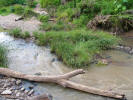
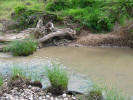
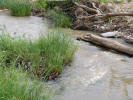
How to cross a river without getting wet
The Maasai, being totally used to moving in such terrain, crossed the river quickly and effortlessly. For me, an untrained city dweller with less than ideal shoes for the purpose, balancing on the tree before stepping onto the island was already an act that made the Maasai grin.
Unfortunately, in the reverse direction this is not possible, at least not for me, because both places where it is theoretically possible would require to make a big step on something narrow, then another step, running against some obstacle, in this case either another tree, visible in the third picture, or a stone wall in another possible crossing place. Since I am totally inexperienced, it is difficult for me to estimate the right amount of momentum. Even slightly too little momentum means stepping and immediately falling back into the river, so I would have to have a lot of momentum, which would let me crash into the obstacle. I'm sure the Maasai can do it just easily, but I just didn't want to risk falling into the water or hurting myself.
The Maasai also sometimes just wade through the river with their tyre rubber sandals, because it's so easy, in the place shown in the second picture. I decided to wade through at the deeper place with the dead trees, because there I wouldn't have to walk into the sand and get it into my socks, which, of course, the Maasai don't wear.
I found it funny how something that doesn't even cost the Maasai a thought can become a little technical problem for me.
The local crocodile a couple of meters downstream, a fairly big one that I had admired just before, didn't come to my rescue either, for which I'm eternally grateful.
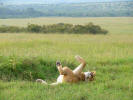
Lioness, sleeping into the evening
In the afternoon I saw several lions and the usual lot of grass-eaters, including an unusually big flock of ostriches, some of which you can see here.
And here's another photo for the "Sunsets from all over the world" box.

Waterbuck under the setting sun
I woke up around 5:30 and left before 6, i.e. before dawn. On the way I met, of course, the hyaena reserchers, who are usually out at this time, so I said one last goodbye and drove on.
As is almost common, Africa doesn't seem to want to let me go. The next I met were two cheetahs who were apparently out hunting. I turned around and followed them for a while, but I couldn't understand their hunting strategy and therefore couldn't know how I should behave best. They just walked without hiding themselves, so the Thompson gazelles saw them, panicked, and ran away in droves.
I followed them almost back down to the river, then had to leave them to drive out. The next I met was a family group of elephants, almost blocking my way. I spent some time with them, then drove on, only to meet two lions, a male and a female.
Eventually I had to go. No photos, because there wasn't enough light. It was one of the grey days, which was very convenient for the long drive, because it remained cool for the rest of the drive. I could even drive with closed windows, used the fan for cooling, and so escaped most of the dust along the road.

Masai Mara (Fig Tree) Narok Nairobi
The road to Masai Mara is truly terrible. Long distances can only be driven at bicycle speed, so this is a good training for one's patience. I arrived at the Aero Club of East Africa around 14 o'clock, which makes the trip, not counting the game drive in the beginning, but without any other break, except refuelling in Narok, about 7 hours long.
I should have taken an extra blanket for the nightit is cool in Nairobi these days. One last shower and a little breakfast, then I drove first to Rasuls to return the car, then Shahid Rasul took me to the airport for my departure on a KLM flight, actually operated by Kenya Airways, to Amsterdam, then on to Munich.
Before I go on, let me summarize this month's repeat experience with the Suzuki Maruti Gypsy I had driven. I had just one tyre failure, and it wasn't even caused by the usual acacia thorns, it was caused by a faulty tube connecting seam. Maybe I have meanwhile learned to almost instinctively avoid the nasty acacia thorn twigs.
Apart from that I had some problems with the rear-viewing mirrors, which were to easy to adjust, so they kept de-adjusted themselves on the rough roads. After learned that they have some kind of play, I could deal with that better by over-adjusting them, then pulling them back, after which they kept their adjustment somewhat better.
The rear door lock failed, as usual, after the Amboseli dust. Dust collects inside the lock and limits its movement. There's no easy solution for that, apparently. In the workshop they take the door apart and clean everything, and then it works again. The windshield washer jets somehow slipped in and disappeared in their hole, such that I could now wash the interior of the dashboard, rather than the windshield. No big deal. And I actually damaged the end of the exhaust pipe by going through a ditch that was slightly too deep, so I squeezed the exhaust between the rear bumper and the ground, making it oval, rather than round. No big deal either, and I can't blame the car for that.
All in all the Suzuki Maruti Gypsy again fulfilled expectations, particularly its extreme reliability. I can recommend this car in the lower price range. Of course the bigger cars can go faster over certain types of rough roads, but on most roads the Gypsy is just as fast as the biggies, and I don't mind driving more slowly, which is less nerve-racking.
The airliner was a Boeing 777-200ER (Extended Range) with 3-3-3 seating. I watched with raised eyebrows how the big bird accelerated with a slight tailwind component and used up a lot of the runway, clearing the far end at a rather low altitude. I'm not sure whether this was a balanced field length takeoff (one in which the pilot has the choice of either taking off on one engine or stopping the plane on the runway when an engine fails at the worst moment during the acceleration). I'm also not sure if the pilot would tell me the truth if I asked. It was rather hazy, and after takeoff we flew very closely past three circling maraboo storks, and if I can recognize the kind of bird from my passenger window, then you can guess how close it was. It wasn't close enough to require evasive action though, and indeed the airliner zoomed straight past the birds. Better not imagine what it means if a big bird hits the windshield of the airliner with a relative speed of 350 km/h.

Flight Nairobi Amsterdam Munich
As to passenger satisfaction, everything was truly excellent. The plane is comfortable and quiet, everybody was friendly, the food was as good as it gets in economy class, and on top of that the flight was almost empty, so I could move to the best window seat I wanted. However, there was one exception.
The crown for the most memorable failure also goes to Kenya Airways in conjunction with the manufacturer of the on-board entertainment system. This was a new system with overlapping movie shows and an excellent range of choices. I skipped most promising ones, because I'll surely watch those later at home, and selected "The Last King Of Scotland", a movie about Idi Amin's scottish doctor. After watching it, I can say that this is also an excellent movie that I recommend highly, better than any I've seen in a long time, except perhaps for the somewhat similar "Hotel Rwanda". The movie is quite fast-paced, which is necessary to squeeze the long, complex, and, to me, very interesting story into a cinema-length movie. I wish for a 4 hour version with much more detail. To be honest, I wouldn't mind a 6 or 8 hour version.
But now my entertainment system story. About half way into the movie the food service began, so I switched over to the map display and enjoyed the food. Imagine my surprise when I found that I could not continue to watch the movie!
If you'd like to have this explained in a little more detail, read on, otherwise skip down a few paragraphs. This particular movie was started in an overlapping fashion every 23 minutes. The menu offers exactly two entry choiceseither I could enter the showing that had begun within the last 23 minutes or I could have the system wait until the next showing begins in less than 23 minutes. But I could not join any longer-running, earlier started showing that was still running on other passengers' screens. The manufacturer simply forgot this function, even though it is technically utterly simple to implement. Either add late entry menu choices or allow to skip forward and back in 23 minute increments, it couldn't be easier.
To Kenya Airways' credit, when I asked two flight attendants, one male, one female, about this function, I first got a semi-correct answer (from the lady, although I actually asked the man in the mistaken belief that he might be more technically competentyet another example for women in scarce, demanding jobs often being more capable than their male counterparts), and when I returned with more details, she came to my seat, tried it for herself, and explained exactly what I feared, in a perfectly professional and competent way. It is certainly not her fault, if Kenya Airways selected a flawed entertainment system. Double credit goes to her, because she probably grew up in a country where most people are exposed to technology from childhood on much less than in an industrialized country.
By the way, in business class you can have your individual showing and skip forward and backward to your liking, but that is no excuse for the incredible stupidity in the design. I also want to mention that, apart from the near-fatal flaw, the entertainment system was better than many I have experienced earlier. The sound was good and the screen, while typically small, was about bright enough, and had a reasonably good contrast range.
The sad thing is that I, and everybody else who runs into this problem, will not run around for years extolling the excellence of the Kenya Airways flightno, the really memorable experience was the frustrating entertainment system, which I will use as an example for idiotic software design decisions for a long time. A chain is only as strong as its weakest link. Also, if they'd put pressure on the manufacturer, this flaw could certainly be fixed with a software update.
I ended up starting the movie afresh and waiting almost an hour until I got to the point where I had interrupted my earlier watch. In that waiting time I wrote the text you are reading, while it was still fresh in my mind.
And I looked out of the window while crossing the Sahara, which takes hours even in a fast-flying airliner. Sometimes I can't believe that I once crossed the Sahara in a light aircraft, which I had modified with an extra tank to allow for 12 hours non-stop flying.
Saw a second movie later, "Eragon", a fantasy movie about a dragon rider. It turned out to be better than I first feared, has many very beautiful pictures, a really cute baby dragon, and the acting is acceptable, particularly taking into account that all actors are not well known. The downside is that the story is good only in some parts and occasionally slow, not to mention the big nonsense factor. I'd call it somewhat entertaining and not too bad for the fantasy genre. Not enough for a recommendation, just an opinion.
Apart from the entertainment system jinx the Kenya Airways flight remained excellent, and I arrived in Amsterdam in good mood and good shape. The connecting flight to Munich ended up being late by 35 minutes, because another plane that brought the crew was late. Still not too bad, and the night approach past the brightly illuminated cities of Augsburg and Munich was spectacular.
I'm back home. First thing that struck me was the high air humidity, then the late dusk, and then the fast Internet.
It is really no comparison. What takes many minutes in Kenya, like checking and filtering a couple of hundred emails or synchronising my large web site, runs in a few seconds here over my home ADSL connection. The difference is two orders of magnitude or more. This is partly due to the service providers' skimping on bandwidth, but also to the more than half-second lag on the Africa-to-rest-of world connection, which apparently runs over a satellite. High time that Kenya gets its eagerly awaited ocean cable.
The downside is that I never really want to leave Kenya, not after a one-month
vacation anyway. If anybody knows a job for me that allows me to shuttle between
Europe and Kenya all the time, please let me know.
![]()
If in this text you find any typos, orthographic errors (even small ones), ungrammatical sentences, wrong or illogical information (like wrong names of birds), if you want me to write more details about something in particular, or if you want one of the photos in full resolution (usually 1,600 x 1,200 pixels), please click on the email sign below and write to me. Many thanks!
Copyright 2007-2023 Hans-Georg Michna.
Private homepage – Hans-Georg Michna
Kenya travel reports: 1999, 2000, 2002, 2003, 2004, 2005, 2006, 2007, 2008, 2009, 2010, 2011, 2012, 2013-Goma, 2013, 2014, 2015, 2016, 2017, 2018, 2019
Kenya Safari Travel Plan, Kenya 1980-2000 photos
hits since 2007-11-01
Free PHP scripts by PHPJunkYard.com